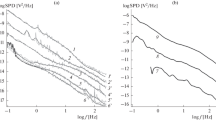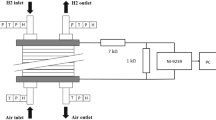Abstract
Electrochemical noise analysis (ENA) technique has been performed for the diagnosis of proton exchange membrane fuel cell (PEMFC) under various operating conditions. The interest of electrochemical noise (EN) measurements relates with its non-invasive character and the possibility of online diagnosis of commercial fuel cells without interruption of the system. A new approach for the interpretation of electrochemical noise (EN) measurements has been proposed. This approach is based on internal intermittence of the recorded fluctuating signal (cell voltage). Namely, statistical descriptors in time domain (standard deviation, skewness, flatness), calculated for small time windows (short-time analysis), are rather unstable. This phenomenon can be called the internal intermittence of EN. Our experiments show that the level of internal intermittence is very sensitive to water management and increases drastically when a fuel cell meets either flooding or drying conditions. This conclusion has been confirmed using three statistical moments (standard deviation, skewness, and flatness), four different relative humidities, and three operation points (OCV, 2.5 A, 8 A). The level of internal intermittence can be detected easily by different ways and can be used for the characterization of possible faults of water management in practical applications as commercial fuel cell stacks. From a practical point of view, the measurement of the level of the internal intermittence is rather simple and avoids a time drift. In our knowledge, the internal intermittence of EN has not been used previously for studies of fuel cells. It will be interesting to apply this approach for other electrochemical systems and processes.








Similar content being viewed by others
References
Li H, Li H, Tang Y, Wang Z, Shi Z, Wu S et al (2008) A review of water flooding issues in the proton exchange membrane fuel cell. J Power Sources 178(1):103–117. https://doi.org/10.1016/j.jpowsour.2007.12.068
Ji M, Wei Z (2009) A review of water management in polymer electrolyte membrane fuel cells. Energies 2(4):1057–1106. https://doi.org/10.3390/en20401057
Rodríguez CMB, Paleta MAR, Marquez JAR, Pachuca BA, de la Vega JRG (2009) Effect of a rigid gas diffusion media applied as distributor of reagents in a PEMFC in operation, part I: dry gases. Int J Electrochem Sci 4:1754–1769
Pérez-Page M, Pérez-Herranz V (2011) Effect of the operation and humidification temperatures on the performance of a PEM fuel cell stack on dead-end mode. Int J Electrochem Sci 6:492–505
Denisov E (2011) PEM fuel cell electrical fluctuations and noises and their diagnostic properties. Thesis, Poitiers
Fecarotti C, Andrews J, Chen R (2016) A Petri net approach for performance modelling of polymer electrolyte membrane fuel cell systems. Int J Hydrog Energy 41(28):12242–122260. https://doi.org/10.1016/j.ijhydene.2016.05.138
Si C, Lu G, Wang XD, Lee DJ (2016) Gas diffusion layer properties on the performance of proton exchange membrane fuel cell: pc-s relationship with K-function. Int J Hydrog Energy 4:21827–21837
Jheng LC, Chang WJY, Hsu SLC, Cheng PY (2016) Durability of symmetrically and asymmetrically porous polybenzimidazole membranes for high temperature proton exchange membrane fuel cells. J Power Sources 323:57–66. https://doi.org/10.1016/j.jpowsour.2016.05.043
Wang W, Chen S, Li J, Wang W (2015) Fabrication of catalyst coated membrane with screen printing method in a proton exchange membrane fuel cell. Int J Hydrog Energy 40(13):4649–4658. https://doi.org/10.1016/j.ijhydene.2015.02.027
Nigmatullin RR, Martemianov S, Evdokimov YK, Denisov E, Thomas A, Adiutantov N (2016) New approach for PEMFC diagnostics based on quantitative description of quasi-periodic oscillations. Int J Hydrog Energy 41(29):12582–12590. https://doi.org/10.1016/j.ijhydene.2016.06.011
Khanungkhid P, Piumsomboon P (2014) 200W PEM fuel cell stack with online model-based monitoring system. Eng J 18:14–26
Khazaee I, Ghazikhani M, Mohammadiun M (2012) Experimental and thermodynamic investigation of a triangular channel geometry PEM fuel cell at different operating conditions. Sci Iranica 19(3):585–593. https://doi.org/10.1016/j.scient.2011.11.039
Martemianov S, Ilie VR, Coutanceau C (2014) Improvement of the proton exchange membrane fuel cell performances by optimization of the hot pressing process for membrane electrode assembly. J Solid State Electrochem 18(5):1261–1269. https://doi.org/10.1007/s10008-013-2273-2
Fang SY, Teoh LG, Huang RH, Chao WK, Lin TJ, Yang KC, Hsueh KL, Shieu FS (2014) Effect of adding zinc oxide particles to the anode catalyst layer on the performance of a proton-exchange membrane fuel cell. J Electron Mater 43(9):3601–3610. https://doi.org/10.1007/s11664-014-3246-7
Thomas A, Maranzana G, Didierjean S, Dillet J, Lottin O (2013) Measurements of electrode temperatures, heat and water fluxes in PEMFCs: conclusions about transfer mechanisms. J Electrochem Soc 160:F191–F204
Banerjee R, Howe D, Mejia V, Kandlikar SG (2014) Experimental validation of two-phase pressure drop multiplier as a diagnostic tool for characterizing PEM fuel cell performance. Int J Hydrog Energy 39(31):17791–17801. https://doi.org/10.1016/j.ijhydene.2014.08.118
Dotelli G, Ferrero R, Stampino PG, Latorrata S, Toscani S (2016) Combining electrical and pressure measurements for early flooding detection in a PEM fuel cell. IEEE Trans Instrum Meas 65(5):1007–1014. https://doi.org/10.1109/TIM.2015.2490999
Dotelli G, Ferrero R, Stampino PG, Latorrata S, Toscani S (2014) Diagnosis of PEM fuel cell drying and flooding based on power converter ripple. IEEE Trans Instrum Meas 63(10):2341–2348. https://doi.org/10.1109/TIM.2014.2318371
St-Pierre J (2007) PEMFC in situ liquid-water-content monitoring status. J Electrochem Soc 154(7):B724–B731. https://doi.org/10.1149/1.2737542
Hauer KH, Potthast R, Wüster T, Stolten D (2005) Magnetotomography—a new method for analysing fuel cell performance and quality. J Power Sources 143(1-2):67–74. https://doi.org/10.1016/j.jpowsour.2004.11.054
Rubio MA, Urquia A, Dormido S (2007) Diagnosis of PEM fuel cells through current interruption. J Power Sources 171(2):670–677. https://doi.org/10.1016/j.jpowsour.2007.06.072
Ito K, Ashikaga K, Masuda H, Oshima T, Kakimoto Y, Sasaki K (2008) Estimation of flooding in PEMFC gas diffusion layer by differential pressure measurement. J Power Sources 175(2):732–738. https://doi.org/10.1016/j.jpowsour.2007.10.019
Barbir F, Gorgun H, Wang X (2005) Relationship between pressure drop and cell resistance as a diagnostic tool for PEM fuel cells. J Power Sources 141(1):96–101. https://doi.org/10.1016/j.jpowsour.2004.08.055
Legros B, Thivel PX, Bultel Y, Nogueira RP (2011) First results on PEMFC diagnosis by electrochemical noise. Electrochem Commun 13(12):1514–1516. https://doi.org/10.1016/j.elecom.2011.10.007
Miramontes JA, Nieves-Mendoza D, Castillo-González E, Almeraya-Calderón F (2014) Electrochemical noise analysis of nickel based superalloys in acid solutions. Int J Electrochem Sci 9:523–523
Vorotyntsev MA, Martem’Yanov SA, Grafov MB (1984) Temporal correlation of current pulsations at one or several electrodes: a technique to study hydrodynamic fluctuation characteristics of a turbulent flow. J Electroanal Chem Interfacial Electrochem 179(1-2):1–23. https://doi.org/10.1016/S0022-0728(84)80270-3
Adolphe X, Danaila L, Martemianov S (2007) On the small-scale statistics of turbulent mixing in electrochemical systems. J Electroanal Chem 600(1):119–130. https://doi.org/10.1016/j.jelechem.2006.04.023
Martemianov S, Danaila L (2003) On the study of electrochemical turbulent noise in a stirred vessel. Fluct Noise Letters 3(04):L463–L471. https://doi.org/10.1142/S0219477503001555
Gabrielli C, Huet F, Keddam M (1985) Characterization of electrolytic bubble evolution by spectral analysis. Application to a corroding electrode. J Appl Electrochem 15(4):503–508. https://doi.org/10.1007/BF01059291
Hodgson DR (1996) Application of electrochemical noise and in situ microscopy to the study of bubble evolution on chlorine evolving anodes. Electrochim Acta 41(4):605–609. https://doi.org/10.1016/0013-4686(95)00347-9
Searson PC, Dawson JL (1988) Analysis of electrochemical noise generated by corroding electrodes under open-circuit conditions. J Electrochem Soc 135(8):1908–1915. https://doi.org/10.1149/1.2096177
Mansfeld F, Lee CC (1997) The frequency dependence of the noise resistance for polymer-coated metals. J Electrochem Soc 144(6):2068–2071. https://doi.org/10.1149/1.1837743
Bertocci U, Frydman J, Gabrielli C, Huet F, Keddam M (1998) Analysis of electrochemical noise by power spectral density applied to corrosion studies maximum entropy method or fast Fourier transform. J Electrochem Soc 145(8):2780–2786. https://doi.org/10.1149/1.1838714
Gabrielli C, Keddam M (1992) Review of applications of impedance and noise analysis to uniform and localized corrosion. Corrosion 48(10):794–811. https://doi.org/10.5006/1.3315878
Gabrielli C, Huet F, Keddam M (1986) Investigation of electrochemical processes by an electrochemical noise analysis. Theoretical and experimental aspects in potentiostatic regime. Electrochim Acta 31(8):1025–1039. https://doi.org/10.1016/0013-4686(86)80018-4
Denisov ES, Evdokimov YK, Martemianov S, Thomas A, Adiutantov N (2016) Electrochemical noise as a diagnostic tool for PEMFC. Fuel Cell 17:225–237
Huet F, Nogueira RP, Lailler P, Torcheux L (2006) Investigation of the high-frequency resistance of a lead-acid battery. J Power Sources 158(2):1012–1018. https://doi.org/10.1016/j.jpowsour.2005.11.026
Baert DHJ, Vervaet AAK (2003) Small bandwidth measurement of the noise voltage of batteries. J Power Sources 114(2):357–365. https://doi.org/10.1016/S0378-7753(02)00599-2
Martemianov S, Adiutantov N, Evdokimov YK, Madier L, Maillard F, Thomas A (2015) New methodology of electrochemical noise analysis and applications for commercial Li-ion batteries. J Solid State Electrochem 19(9):2803–2810. https://doi.org/10.1007/s10008-015-2855-2
Martemianov S, Maillard F, Thomas A, Lagonotte P, Madier L (2016) Noise diagnosis of commercial Li-ion batteries using high-order moments. Russ J Electrochem 52(12):1122–1130. https://doi.org/10.1134/S1023193516120089
Greisiger H, Schauer T (2000) On the interpretation of the electrochemical noise data for coatings. Prog Org Coat 39(1):31–36. https://doi.org/10.1016/S0300-9440(00)00096-5
Xiao H, Mansfeld F (1994) Evaluation of coating degradation with electrochemical impedance spectroscopy and electrochemical noise analysis. J Electrochem Soc 141(9):2332–2337. https://doi.org/10.1149/1.2055121
Rubio MA, Bethune K, Urquia A, St-Pierre J (2016) Proton exchange membrane fuel cell failure mode early diagnosis with wavelet analysis of electrochemical noise. Int J Hydrog Energy 41(33):14991–15001. https://doi.org/10.1016/j.ijhydene.2016.05.292
Maizia R, Dib A, Thomas A, Martemianov S (2017) Proton exchange membrane fuel cell diagnosis by spectral characterization of the electrochemical noise. J Power Sources 342:553–561. https://doi.org/10.1016/j.jpowsour.2016.12.053
Bahrami MJ, Shahidi M, Hosseini SMA (2014) Comparison of electrochemical current noise signals arising from symmetrical and asymmetrical electrodes made of Al alloys at different pH values using statistical and wavelet analysis. Part I: neutral and acidic solutions. Electrochim Acta 148:127–144. https://doi.org/10.1016/j.electacta.2014.10.031
Aballe A, Bethencourt M, Botana FJ, Marcos M (1999) Using wavelets transform in the analysis of electrochemical noise data. Electrochim Acta 44(26):4805–4816. https://doi.org/10.1016/S0013-4686(99)00222-4
Maillard F (2015) Méthodologie de diagnostic des batteries Li-ion par la mesure des bruits électrochimiques. Thesis; Poitiers, France
Shahidi M, Jafari AH, Hosseini SMA (2012) Comparison of symmetrical and asymmetrical cells by statistical and wavelet analysis of electrochemical noise data. Corrosion 68(11):1003–1013. https://doi.org/10.5006/0626
Mansfeld F, Sun Z, Hsu CH (2006) Electrochemical noise analysis (ENA) for active and passive systems in chloride media. Electrochim Acta 46:3651–3664
Cottis RA, Al-Awadhi MAA, Al-Mazeedi H, Turgoose S (2001) Measures for the detection of localized corrosion with electrochemical noise. Electrochim Acta 46(24-25):3665–3674. https://doi.org/10.1016/S0013-4686(01)00645-4
Xia DH, Behnamian Y (2015) Electrochemical noise: a review of experimental setup, instrumentation and DC removal. Russ J Electrochem 51(7):593–601. https://doi.org/10.1134/S1023193515070071
Homborg AM, Tinga T, Zhang X, van Westing EPM, Oonincx PJ, Ferrari GM, de Wit JHW, Mol JMC (2013) Transient analysis through Hilbert spectra of electrochemical noise signals for the identification of localized corrosion of stainless steel. Electrochim Acta 104:84–93. https://doi.org/10.1016/j.electacta.2013.04.085
Acknowledgements
This work was supported by the Algeria Government program (PNE scholarship of University A. Mira of Bejaia) and French Government program “Investissements d’Avenir” (LABEX INTERACTIFS, reference ANR-11-LABX-0017-01).
Author information
Authors and Affiliations
Corresponding author
Rights and permissions
About this article
Cite this article
Maizia, R., Dib, A., Thomas, A. et al. Statistical short-time analysis of electrochemical noise generated within a proton exchange membrane fuel cell. J Solid State Electrochem 22, 1649–1660 (2018). https://doi.org/10.1007/s10008-017-3848-0
Received:
Revised:
Accepted:
Published:
Issue Date:
DOI: https://doi.org/10.1007/s10008-017-3848-0




